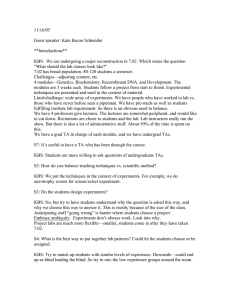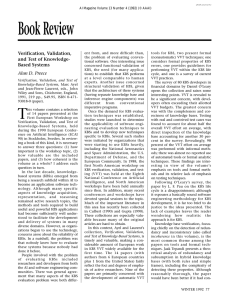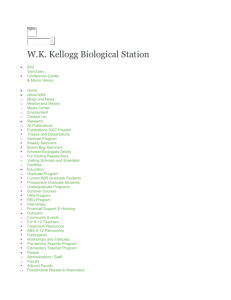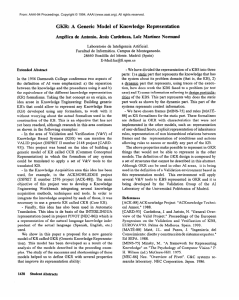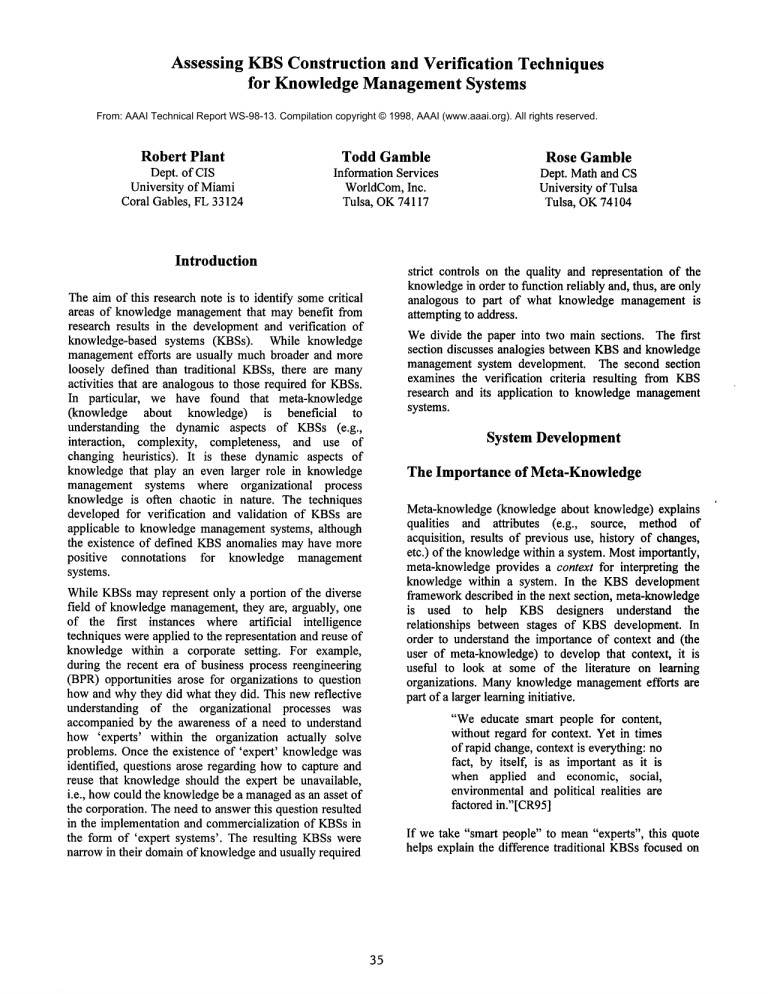
Assessing
KBS Construction and Verification
Techniques
for Knowledge Management Systems
From: AAAI Technical Report WS-98-13. Compilation copyright © 1998, AAAI (www.aaai.org). All rights reserved.
Robert Plant
Dept. of CIS
University of Miami
Coral Gables, FL 33124
Todd Gamble
Rose Gamble
Information Services
WorldCom,Inc.
Tulsa, OK74117
Dept. Math and CS
University of Tulsa
Tulsa, OK74104
Introduction
The aim of this research note is to identify somecritical
areas of knowledge managementthat may benefit from
research results in the development and verification of
knowledge-based systems (KBSs). While knowledge
managementefforts are usually much broader and more
loosely defined than traditional KBSs,there are many
activities that are analogous to those required for KBSs.
In particular,
we have found that meta-knowledge
(knowledge about knowledge) is beneficial
understanding the dynamic aspects of KBSs (e.g.,
interaction,
complexity, completeness, and use of
changing heuristics). It is these dynamic aspects of
knowledge that play an even larger role in knowledge
management systems where organizational
process
knowledge is often chaotic in nature. The techniques
developed for verification and validation of KBSsare
applicable to knowledge managementsystems, although
the existence of defined KBSanomalies may have more
positive connotations
for knowledge management
systems.
While KBSsmayrepresent only a portion of the diverse
field of knowledgemanagement,they are, arguably, one
of the first instances where artificial
intelligence
techniques were applied to the representation and reuse of
knowledge within a corporate setting. For example,
during the recent era of business process reengineering
(BPR)opportunities arose for organizations to question
howand why they did what they did. This new reflective
understanding of the organizational processes was
accompanied by the awareness of a need to understand
how ’experts’ within the organization actually solve
problems. Once the existence of ’expert’ knowledgewas
identified, questions arose regarding howto capture and
reuse that knowledgeshould the expert be unavailable,
i.e., howcould the knowledgebe a managedas an asset of
the corporation. The need to answerthis question resulted
in the implementation and commercialization of KBSsin
the form of ’expert systems’. The resulting KBSswere
narrow in their domainof knowledgeand usually required
strict controls on the quality and representation of the
knowledgein order to function reliably and, thus, are only
analogous to part of what knowledge management is
attempting to address.
Wedivide the paper into two main sections. The fin’st
section discusses analogies between KBSand knowledge
management system development. The second section
examines the verification criteria resulting from KBS
research and its application to knowledge management
systems.
System Development
The Importance of Meta-Knowledge
Meta-knowledge (knowledge about knowledge) explains
qualities and attributes (e.g., source, method of
acquisition, results of previous use, history of changes,
etc.) of the knowledgewithin a system. Most importantly,
meta-knowledgeprovides a context for interpreting the
knowledge within a system. In the KBS development
frameworkdescribed in the next section, meta-knowledge
is used to help KBS designers
understand
the
relationships between stages of KBSdevelopment. In
order to understand the importance of context and (the
user of meta-knowledge)to develop that context, it is
useful to look at some of the literature on learning
organizations. Manyknowledge managementefforts are
part of a larger learninginitiative.
"Weeducate smart people for content,
without regard for context. Yet in times
of rapid change, context is everything: no
fact, by itself, is as important as it is
when applied and economic, social,
environmentaland political realities are
factored in."[CR95]
If we take "smart people" to mean"experts", this quote
helps explain the difference traditional KBSsfocused on
35
narrow domains of knowledge expressed in facts and
rules and current knowledgemanagementwhich seeks to
include contextual information in the form of metaknowledge.
A Methodological
Development
the refinement process. Subsequentto this, the knowledge
is refmedinto a codedsystem.
Application to Knowledge-Management
System
Concerns
Framework
The methodology
for KBS design and
developmentcan also act as foundation for a methodology
for knowledge management system design. The chief
componentof the methodologyis based upon using metaknowledge as a tracking agent, which is a primary
information source in knowledge management [DP98].
Meta-knowledge can be decomposed into two forms
static and dynamic. Static knowledge relates to the
structure of the knowledge.Dynamicknowledgerelates to
the execution of the knowledge. The dynamic knowledge
is defined at the object level and contains information
about the task domain.The object level itself is described
through using a meta-level of information (see [PG97]for
a detailed discussion).
In order for organizations
to create a knowledge
managementenvironment, they need to base their self
understanding
or meta-knowledge upon a solid
methodological
framework.
We use the KBS
development methodology previously defined by [PG97]
and depicted in the figure below to suggest how the
methodologycould be amendedto further assist the needs
of the knowledge managementcommunity.
Technologies from Knowledge-Based Systems
Development
As suggested earlier, manyof the issues now facing the
knowledgemanager1 of a corporation have been faced in
a similar form by knowledge-basedsystems practitioners
in the past. A large amountof research has been focused
upon the development of KBSsystems, however, without
a connective framework around which the individual
specialized aspects of KBSsystems research could be
placed, the research was difficult to link together in a
useful manner. The framework def’med by [PR97]
proposes the use of a meta-knowledge model to link
together the stages of systemcreation utilizing Newell’s
KnowledgeLevel construct [NA82].
Knowledgemanagementsystems require a ref’mement of
this knowledge model for applicability.
The metaknowledge in our descriptive
language is used to
represent information regarding the properties of the
enterprise that are modeledat the object level. Thus, the
object level will describe the knowledgeand information
that identifies the knowledgeassets a companypossesses,
but the meta-level information will answer the questions,
such as, where is the knowledge asset, what does it
contain, what is its use, what form is it in, and how
accessible is it? This meta-level information is ultimately
placed in the formal domainspecification at the Formal
Level of the development methodology above. The
representation
of the knowledge in the knowledge
management system is often in the form of data
warehouses, databases and KBSs. Thus, the issue of
representational
selection is addressed via the
representation specification at the Formal Level of the
design process.
The methodology takes an initial specification of the
system to be created and utilizes the meta-knowledge
surrounding the project to create a more definitive
baseline specification of the system. This specification is
then acted upon in the knowledgeelicitation phase again
utilizing meta-knowledge to drive the process. The
difficulty at the elicitation stage is that the knowledge
may well be in manyformats, makingthe validation and
verification process extremelydifficult. Hencethe needto
create an intermediate representation of the knowledgein
a semi-formalnotation. This initial representation allows
for gross validation issues to be recognized and the
elicitation cycle to be repeated until the issue has been
clarified. As a critical massof the systemis defined, the
information, data, knowledge and meta-knowledge is
focused into a formal notation upon which rigorous
verification can take place. These are the domain,
cognitive, and representation specifications.
These
separate specification categories allow the knowledge,the
interface, and representational issues to be focused upon
individually but aligned through the meta-knowledgeand
Manyorganizations have officially designated an
executive position the CKOor Chief KnowledgeOfficer.
36
Prototyping
,
i
~
"1 Initial
I~tdell"
’
Specification I
BT:2~n:ments
8 ..... l .................................
l specificati°n ......
Knowledge
Elicitation
T
~
I ]Elicited KnowledgeRepresentation
m
,
Knowledge
Acquisition
~
i
nowledge
filte
i°dit
I Intermediate KnowledgeRepresentation I
,...............
Form
...........
Fina’
.......................
.............
I.termediate
Ir l°del I
I II Representation
~
DomainSpecification
Cognitive Engineering Specification
I Representation Specification
[
Cpni/iiitiln...........
CodeCreationi .......
"ii....................................
A Development Methodology for Knowledge-based Systems [PG97}
Verification
and Validation
Concerns
Research in KBS verification
and validation
has
established a set of anomalies whose existence in a KBS
could cause problems. As a result, many theories,
techniques, and systems have been develop to verify the
absence of the anomalies, usually by first detecting the
potential occurrences and then by investigating further
when the occurrences can cause real problems, e.g.,
[0093, PA90, SV96, GL95, PL94].
The anomalies are partitioned across categories of
redundancy,
inconsistency,
and incompleteness.
Redundancyimplies that multiple knowledgestructures
use the same information and lead to the conclusions.
Inconsistency implies that multiple knowledgestructures
use the same information and lead to conflicting
conclusions. Incompleteness implies that there is
insufficient knowledgeto make a conclusion. There are
smaller classes of anomalies that are present in each
category.
37
In KBSs,these anomalies can be quite debilitating. While
redundancy may not be a problem in a static KBS,
imagine a KBSin which a piece of knowledgewas found
to be incorrect and is then deleted. However,it is not
knownthat this knowledgeexists redundantly in the KBS
and, therefore, remains though it was believed to be
deleted. Inconsistency can cause incorrect or nondeterministic answers depending on the reasoning path
taken each time the KBSexecutes. Incompleteness may
result in no available conclusions from the KBS.
However,in somecases such anomalies are desired in the
KBS.Thus, detection mechanismsusually find potential
occurrences and then correct only those that have been
investigated further.
For knowledge management systems, these anomalous
criteria remain meaningful and generally detectable,
thoughnot necessarily by automatedmeans.This is due to
the multiple representation paradigms used to configure
knowledge in a knowledge management system.
However,the response to an anomalousoccurrence is not
generally analogous to that for a KBS.In this regard, we
briefly look at each category of anomalies and discuss
them in the context of knowledgemanagementsystems.
focused on production rules. However, knowledge for
knowledge managementsystems may be very diverse and
for each representational format, different detection
mechanisms may be needed.
Redundancy
Within a single KBS, knowledge is represented in a
consistent manner. In a knowledge managementsystem,
knowledgemay be represented in multiple formats. For
example, in the field of software architecture [SHG96],
knowledgeof the architectural style of a software system
could be stored in multiple ways: diagrammatically,
formal models, and natural language [SG97]. This
knowledge is redundant though each format may be
neededfor a different context. Withrespect to providing a
means of communicating knowledge (a very important
knowledge
repeated
management
function),
representation and access may be crucial.
Thus,
redundancy can be a key feature in a knowledge
management system in order to verify that there is a
shared understanding among the stakeholders of the
system.
References
[CR95]
[DP98]
[GL95]
[NA82]
[0093]
Inconsistency
Inconsistency in a knowledgemanagementmayindicate a
conflict or an incorrect input to the system as in KBSs.
However, in knowledge management, inconsistency may
also indicate innovation or a shift in business models.
Thus, positive, not simply non-deterministic, outcomes
mayarise from inconsistent knowledge.
[PA90]
[PG971
Incompleteness
While KBSdevelopers strive to overcomeincompleteness
in the system, it is accepted, and even taken for granted,
within a knowledge management system since most
organizations are continually learning and changing.
Multiple representations, multiple stakeholders, and
multiple contributors all indicate that there will be gaps in
the complex knowledgethe system maintains.
[PA97]
[SHG96]
Detection
[SG97]
Further research needs to be performed to determine if
there exists a common
abstract representation from which
to detect potential anomalies in a knowledgemanagement
system and to define whenthere are harmful. Returning to
the software architecture example, redundancyas detected
is a plus to the system knowledge.Onceit is detected, it
must be shown that there is consistency across
representations of the redundant knowledge.This is very
difficult
to perform without a stable medium of
representation. In addition, detection for KBSshas mainly
38
[SV96]
Chawla,S., and Renesch,J. (1995),
Learning Organizations, Productivity
Press, 1995.
Davenport,T.H., and Prusak, L. (1998),
Working Knowledge: How
Organizations ManageWhat They
Know,Harvard Business School Press,
1998.
Gamble, R. and Landauer, C. (1995),
Validation
and Verification
of
Knowledge-Based Systems. Workshop
Notes IJCAI-95, Montreal, Quebec.
Canada.
Newell, A., (1982), The knowledgelevel, AI, 18:87-127.
O’Keefe, R. and O’Leary, D.E. (1993),
Expert system verification
and
validation: A survey and tutorial,
Artificial Intelligence Review,7:3 - 42.
Preece,A.D.,
Shinghal, R.,
and
Batarek, A. (1992), Verifying expert
systems: A logical framework and
practical tool, Expert Systems with
Applications, 5:421-436.
Plant, R.T., and Gamble., R. (1997),
Using Meta-Knowledgewithin a MultiLevel Frameworkfor KBS
Development,International Journal of
Human-ComputerStudies, 46:523-547.
Plant, R.T., and Antoniou, G. (1997),
Validation
and Verification
of
Knowledge-Based Systems. Workshop
Notes AAAI-97, Boston, MA.
Shaw, M. and Garlan, D. (1996),
Software Architecture: Perspectives on
an EmergingDiscipline, Prentice Hall.
Stiger, T. and Gamble,R.F. (1997),
Blackboard systems formalized within a
software architectural style, with T.
Stiger, 1EEEInt’l Conf. on Systems,
Man, and Cybernetics, October.
Schmolze, J. and Vermesan, A. (1996),
Validation
and Verification
of
Knowledge-Based Systems. Workshop
Notes AAAI-96,Portland, OR.

